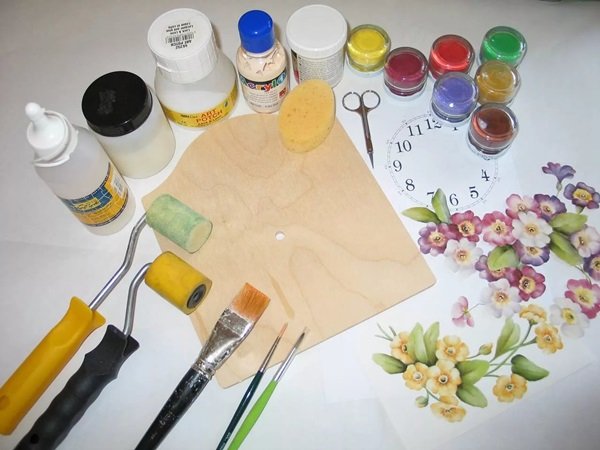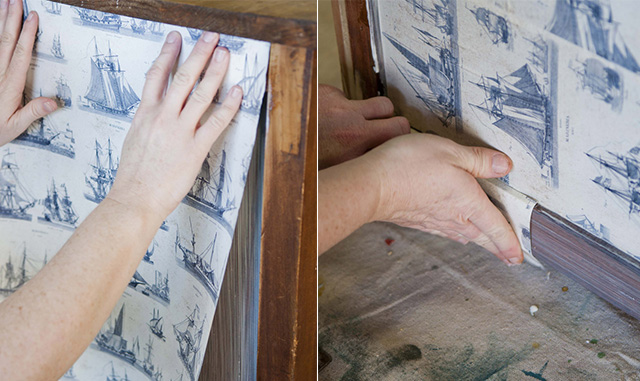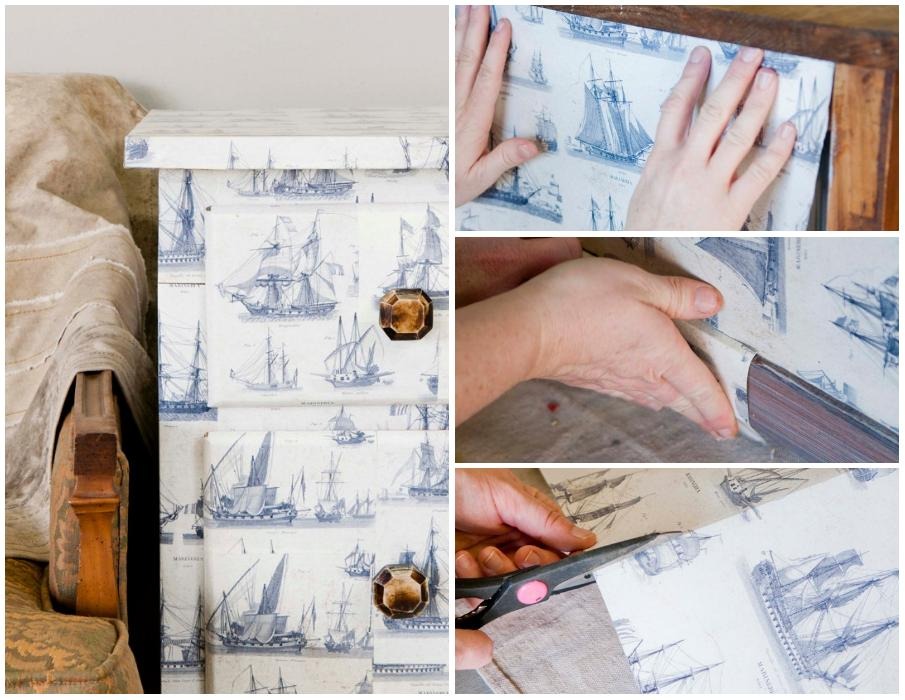Ways of decoupage cabinets, popular techniques

You can learn the basics of decorating furniture at home by performing decoupage of a cabinet, for example, in the Provence style. The benefit will be not only financially, but also in the possibility of manufacturing exclusive furniture, using inexpensive materials.
Content
What is decoupage
Using the special technique of decorating antique objects or decoupage, you can completely change the appearance of the product, make it unique. Most often, the ornament is attached to the decorated cabinet, and then treated with varnish. In order to restore the products it is not necessary to undergo special training, you can use video clips and photo examples. You can make decoupage with your own wallpaper or colored paper, and then decorate everything with gilded paint or decor elements.
Room decoration can be a bookcase or bookcase glued with napkins or pictures from magazines. You can achieve the best effect by using several layers of varnish, thereby creating the feeling of a painted canvas, and paints will give the furniture clear contours.
Decoupage began to develop in China, after which it gained popularity in Europe. This type of decor gained particular popularity in France, where for the first time they began to actively resort to the Provence style technique. A kind of work of art was created, using interior items, hats and caskets as examples. The simplicity of manufacture and the availability of materials in home use have made decoupage one of the most popular areas of decoration.
Foundation requirements
The preparatory stage for creating cabinets by decoupage is the choice of basis, most often it is a tree or chipboard. Wooden products look harmonious with papier-mâché, tin or glass inserts. Especially carefully you need to use a plastic base, as the technique may simply not work.
When choosing a basis for decoupage, you should adhere to the rules:
- the wooden surface is treated with emery paper to smooth it well. If there are furrows, then they are filled with a special wood putty, after which they are sanded until the surface is smooth;
- glass products must be well washed and dried so that no lint is left. It is important to degrease the surface before starting work;
- tin objects are well cleaned with water and vinegar mixed in a 1: 1 ratio. If the sheet has rusty spots, then they can be easily cleaned with a brush or brush with wire.
Materials used
The advantage of decoupage technology is that you can find everything you need at home, for example, magazine covers, printed pages from books, and more.
Required decoupage materials:
- basis for drawing drawings.The most common are pieces of furniture, the restoration of which turns into the receipt of works of art. But, besides this, caskets, flower pots, mirror elements, lampshades, trays and kitchen utensils are used;
- one of the main elements is glue, which can be either professional, specially developed for decoupage technique, or ordinary office PVA;
- Emery paper is necessary for grinding surfaces, getting rid of unevenness. When choosing sandpaper pay attention to the degree of graininess;
- paints are simply necessary to emphasize the exact lines of the product, giving the background the desired shade and drawing details. In order for the paint to fit well on the product, it is better to use acrylic, especially since its palette is more than diverse. Conveniently, before drying it can be washed off with water. Replace acrylic paint with water-based. To get very light shades, almost translucent, a solvent should be added to the paint;
- priming is needed for finishing wooden surfaces, for example, Provence style furniture with many lockers. When using an acrylic primer, wood will not absorb paint. To smooth the surface to perfect condition, an acrylic putty is also used, which is sold in almost all construction stores. If the object of decoupage is any other surface, then the primer is ordinary acrylic paint;
- varnish is used as protection against external influences and fixing agent. It is used at the beginning and at the end of the work, while it must have an acrylic base. It is convenient to use a spray varnish, which can be found in any hardware store. Creating a closet or chiffonier in the Provence style will not do without a special craquelure varnish, which creates a crackle effect. After applying with brushes, an image with cracks is created on the surface of the product. The created mesh of cracks can be of different thicknesses, it all depends on the number of times the paint is applied. The directions of the cracks can be diverse, it all depends on the imagination of the person;
- brushes are an essential attribute for applying paint or varnish, but recently they prefer synthetic to avoid shedding. Only after practicing in several works does a person select the necessary brush number for himself;
- when working with paper, clippings from magazines use scissors, they must be well sharpened and smoothly cut;
- an ordinary sponge will help in creating drawings on large canvases;
- The roller is useful in case you need to glue large paintings onto the surface.
It can be seen from the list of materials that each person has a large part of them at home, and only a small part will need to be purchased. In addition to the basic materials, a cabinet may require a hair dryer to dry the surface, toothpicks and cotton buds, and masking tape.
Miscellaneous techniques
You can make decoupage with your own hands using paper using different techniques. There are five main varieties:
- classic
- reverse;
- art;
- volumetric;
- de-patch.
Classic version
Suitable for beginners and is the basic method for decorating furniture. Furniture restored by this method is a product with a pattern of beautiful napkins, pictures from a printer or vintage drawings. Varieties of the base are wood, MDF, glass, fabric or cardboard, leather. The base must be thoroughly prepared before starting drawing, degreased with alcohol, in the case of a fabric, ironed.
If wipes are selected, they should be three-layer, decoupage cards are blotted with warm water before use. Gluing of drawings is carried out by wet, dry and hot methods. The decoupage of an old cabinet with printed pictures on a printer first begins with thinning the paper and implanting it into the surface by gluing it with the front side. Having removed the upper layers with water, the picture is varnished and dried. Then the picture is again wetted and a white layer of paper is removed, after which only a transparent layer of the picture remains on the surface. The image is transferred to the product with a regular spoon, acetone or a cream-based cleanser.
Reverse technique
Includes decoration of glass surfaces. The peculiarity of the application of the method is that the pictures are glued with the front side to the glass from the inside of the cabinet, completely opposite to the direct classic version. First of all, a napkin is glued from the inside to the side of itself, then the contours of the painting and color are applied, only after that the primer is applied. To protect the surface from abrasion, the outside is varnished using the classical decoupage technique. Thus, the pattern will be under the glass, which will increase the durability of the product. In theory, it is difficult to go broke right away in the reverse decoupage technique, but experience will come after practice.
Art method
Even a person without experience in drawing can master the technique of artistic decoupage, having brushes and paints. In some cases, a glued picture requires giving it a color cast by blending or transitions. After the end of work, products can look expensive and, of course, unique. Master classes and videos will help to realize the dream of decorating furniture with decoupage, but it is best to see the manufacturing process live several times. It is convenient to use a paint drying retarder in this method, which will allow you to make soft shading and the desired background.
Decorate products using the art decoupage technique in the afternoon, so that shades can be better seen. But it is worth noting that the paints become dull after drying. The method is used by shading, painting the background and creating shadows. The most common variant of artistic decoupage is shading, when you need to highlight the object with clear contours, and the surrounding background gives the impression of a haze. As with any decoupage method, the surface should be well sanded and leveled. The background is finished in the event that it is required to correct inaccuracies in the picture or to give brightness to secondary elements.
Volumetric option
The volumetric decoupage technique consists in applying a pattern to surfaces having convexities and uneven relief. The method consists in applying various materials to the surface, such as shreds of fabric, paper, dried flowers and herbs, eggshells, texture layers and more. It is very difficult for novice masters to make a product in three-dimensional technology. The most popular Provence style is the finish with modeling paste and putty. Using modeling paste, volumetric models are made that are carefully glued and dried. Using putty, the volume of the part is created, it is applied with a spatula gradually in several layers with hands moistened with water. Then, preventing the product from drying out completely, the motive is glued. Most often you can find artificially made brickwork or wooden boards in the interior of the house.
Depatch
Depatch is a technique of applying paper, newspapers or magazine pictures in a patchwork fashion. The surface is decorated with paper pieces torn by hand or cut out with scissors. For beginners, this is the most suitable decor method, so the pieces are glued with an overlap and form a pattern.Needlework stores sell special paper for decopatch, which does not stretch or wrinkle. You can create the effect of an aged stone by wiping the already pasted pictures with acetone. You can decorate the depatch technique with any product, the main thing is to prepare the surface with primer or paint before work, and the final touch will be varnishing.
Do-it-yourself decoupage of the cabinet should be carried out in such a way that the furniture fits harmoniously into the interior. Having picked up the necessary equipment, the master creates unique pieces of art.
Video


























































